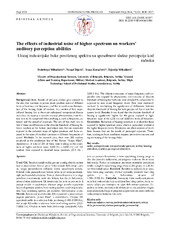Please use this identifier to cite or link to this item:
https://rfos.fon.bg.ac.rs/handle/123456789/1515| Title: | Uticaj industrijske buke povišenog spektra na sposobnost slušne percepcije kod radnika The effects of industrial noise of higher spectrum on workers' auditory perception abilities |
Authors: | Mihailović, Dobrivoje Đurić, Nenad Kovačević, Ivana Mihailović, Đorđe |
Keywords: | srbija;slušna percepcija;sluh;profesionalna izloženost;poremećaji;poremećaji;buka na radnom mestu;serbia;occupational;occupational exposure;noice;hearing disorders;auditory perceptual disorders | Issue Date: | 2016 | Publisher: | Vojnomedicinska akademija - Institut za naučne informacije, Beograd | Abstract: | Uvod/Cilj. Rezultati ranijih studija govore u prilog ideji da mašine koje u proizvodnim halama prave buku različite frekvencije i jačine, mogu prouzrokovati slabljenje slušne sposobnosti radnika. Gubitak sluha prouzrokovan bukom jedno je od najrasprostranjenijih profesionalnih oboljenja. Buka je složeni fenomen, te je stoga potrebno u razmatranje uzeti više faktora, kao što su frekvencija, jačina i dužina izloženosti. Cilj istraživanja bio je da se proveri da li postoje razlike u apsolutnom slušnom pragu između zaposlenih koji su dugotrajno izloženi buci visokog spektra i onih koji su izloženi buci umerenog spektra, pri različitim frekvencijama zvuka. Metode. Istraživanje je obuhvatilo 308 zaposlenih u proizvodnom pogonu preduzeća "Knjaz Miloš" u Aranđelovcu. Ukupno 205 zaposlenih radilo je u uslovima buke povišenog (4 000-8 000 Hz), dok je njih 103 radilo u uslovima buke standardnog spektra (31,5- 2 000,0 Hz). Objektivne mere buke (frekvencije i amplitude) dobijene su pomoću fonometra, a mere apsolutnog slušnog praga za oba uha pomoću audiometra, pri izlaganju zvuku na devet nivoa frekvencija. Podaci su analizirani proverom statističke značajnosti razlika u pogledu apsolutnog praga draži za obe grupe, na svih devet frekventnih nivoa. Rezultati. Rezultati su pokazali da je apsolutni slušni prag značajno viši kod ispitanika izloženih buci višeg spektra i to na frekventnim nivoima od 4 000 i 8 000 Hz. Zaključak. Smanjenje čulne osetljivosti primetno je kod onih radnika koji su izloženi buci višeg spektra, što je naročito vidljivo pri merenjima na višim frekventnim opsezima. Zaposleni su često nesvesni ovih efekata jer su oni posledica dugotrajne izloženosti. Stoga se preporučuju preventivne mere i redovno audiometrijsko testiranje čula sluha. Background/Aim. Results of previous studies gave support to the idea that machines in power plants produce noise of different levels of loudness and frequency, and that it could cause deterioration of the hearing ability of workers. As a matter of fact, noise-induced hearing loss is the most widespread occupational disease nowadays. As noise is a complex acoustic phenomenon, more factors have to be considered when studying it, such as frequency, intensity and the period of exposure. The aim of this study was to find if there are differences in the absolute threshold of hearing between workers in the factory production lines that are constantly exposed to the industrial noise of higher spectrum and those exposed to the noise of standard spectrum at different frequencies of sound. Methods. In the research plan, there were 308 workers employed in the production line of the Factory "Knjaz Miloš", Aranđelovac. A total of 205 of them were working in the conditions of higher spectrum noise (4,000 Hz - 8,000 Hz) and 103 workers were exposed to standard noise spectrum (31.5 Hz -2,000.0 Hz). The objective measures of noise (frequency and amplitude) were acquired by phonometer, and measures of absolute threshold of hearing for both ears were obtained by audiometer by exposure to nine sound frequency levels. Data were statistically analyzed by establishing the significance of differences between absolute thresholds of hearing for both groups and for all nine frequency levels. Results. It was found that the absolute threshold of hearing is significantly higher for the group exposed to high-frequency noise at the 4,000 Hz and 8,000 Hz levels of frequency. Conclusion. Reduction of hearing sensitivity is evident for those exposed to higher spectrum noise, which is particularly evident at the higher frequency levels. Employees are often unaware of its effects because they are the results of prolonged exposure. Therefore, working in those conditions requires preventive measures and regular testing of the hearing ability. |
URI: | https://rfos.fon.bg.ac.rs/handle/123456789/1515 | ISSN: | 0042-8450 |
| Appears in Collections: | Radovi istraživača / Researchers’ publications |
Show full item record
SCOPUSTM
Citations
1
checked on Nov 17, 2025
Page view(s)
10
checked on Dec 14, 2025
Download(s)
8
checked on Dec 14, 2025
Google ScholarTM
Check
Altmetric
This item is licensed under a Creative Commons License


